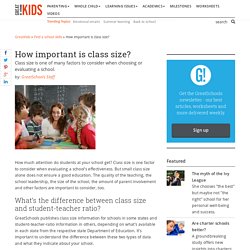

Why Class Size Matters. Across the United States, class sizes are increasing at unprecedented rates.

An estimated 58,000 teachers were laid off in September, at the same time as enrollment was increasing in much of the country. Clearly budget pressures are weighing on states and school districts, but there has also been a fierce attack on the value of class size reduction. So perhaps it is time to review what the research really says and what experience shows about the importance of reducing class size. 1. Fact: Class size is a proven and effective reform. Studies from Tennessee, Wisconsin, and states throughout the country have demonstrated that students who are assigned to smaller classes in grades K-3rd do better in every way that can be measured: they score higher on tests, receive better grades, and exhibit improved attendance. 2.Fact: There is NO threshold that has to be reached before class size reduction provides benefits. 3.
Breaking Down School Budgets. How much does it cost to provide a high school math course?

What about remedial English? An Advanced Placement (AP) course in history? As the economic outlook continues to darken, school districts will be looking for ways to cut costs, and they will no doubt wrestle with some difficult issues. When does it make sense to keep classes small? When does it make sense to increase class sizes to cut costs? School districts produce reams of financial data to check off the right boxes on accounting and compliance reports required by states and the federal government. Computing spending patterns is not difficult. While the findings are not intended to be suggestive of all districts in the country, the work does demonstrate how such fiscal metrics can reveal the financial implications of the inner workings of individual high schools.
Spending on Services. Budget Cuts+Teacher Layoffs=Larger Class Sizes. By Amanda Litvinov In communities across the country, teachers are returning to classrooms with noticeably less elbow room.

State and district level budget cuts that led to teacher layoffs have resulted in larger class sizes for some, including Melissa Hagen of Phoenix. Last year her junior high science classes ranged from 22 to 30 students per class, but after losing two colleagues, the count shot up to 38 to 41 per class. “That assumes that all teachers are here or we have a sub,” says Hagen. “If not, I could have around 55 kids in my class.” Hagen won’t be the only one struggling to keep her packed classes focused on the scientific method this year. Some states and districts are still finalizing budgets, figuring out where stimulus (American Recovery and Reinvestment Act) funds might fit into the equation, and determining whether additional educators could be reinstated or added. How important is class size? - Defining your ideal school. "There is way too many kids in the classroom the ratio is more like 32:1.

Teacher is overwhelmed and is not aware of what going on in the class with the students " "I'm of the old school. Children going to school must be pre-motivated. Perhaps all the PreK efforts should make sure that children are properly motivated before entering the 1st grade. Anyhow, 17 in a class is a joke. "I don't think the people who are commenting are fully reading the articles. "the board of education should re-read and understand this before placeing childern in the classroom " "when there are three year olds mixed in with older children the ratio of student to teacher is 1 teacher for every 6 children. that means if you have one three year old and the rest are 4-6 you can only have a total of six children.
"Smaller class sizes cost more money. "I was a student in the first class of a private school in Brooklyn, NY which began with almost no money. Large or Small College? Close your eyes.

When you think about college, do you picture a compact campus where you run into friends between classes? Or do you envision big Saturday-afternoon football games, with thousands of fans cheering on your college's team? Are you participating in small-group discussions or listening carefully to your professor lecture in a large room? There are no right answers to these questions, only what feels right to you. A college's size affects many aspects of the college experience, from your classes and extracurricular activities to your social life.
Learning and Size A college's size often affects the size of its classes. At smaller colleges, you may find fewer lecture courses and more courses that emphasize class participation. Small Colleges vs. Large Universities: The Benefits of Each. Small Colleges vs.

Large Universities: The Benefits of Each Small colleges vs. large universities: this important topic is always up for debate. There are many obvious differences between small colleges and large universities, but there are many that may surprise you. Choosing between a small college and a large university will be an important deciding factor in your college search, and it will also probably be one of the most important. Both types of schools have pros and cons, so make sure you know what to expect from both styles of schools.
Small Colleges: The Pros. Small College Class Size Benefits.